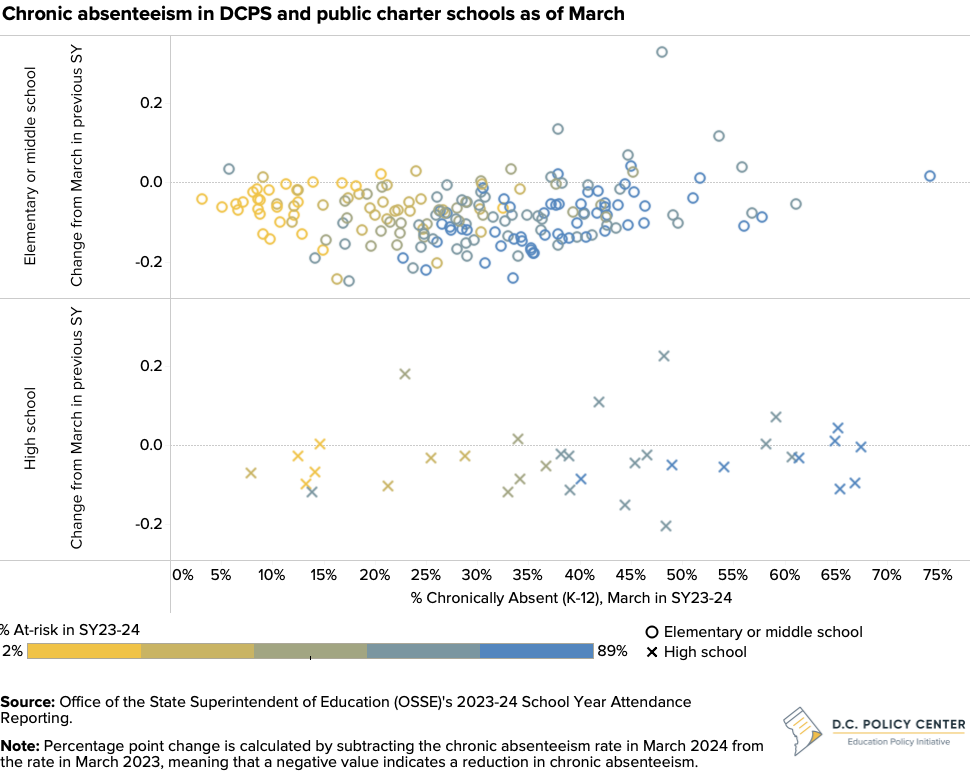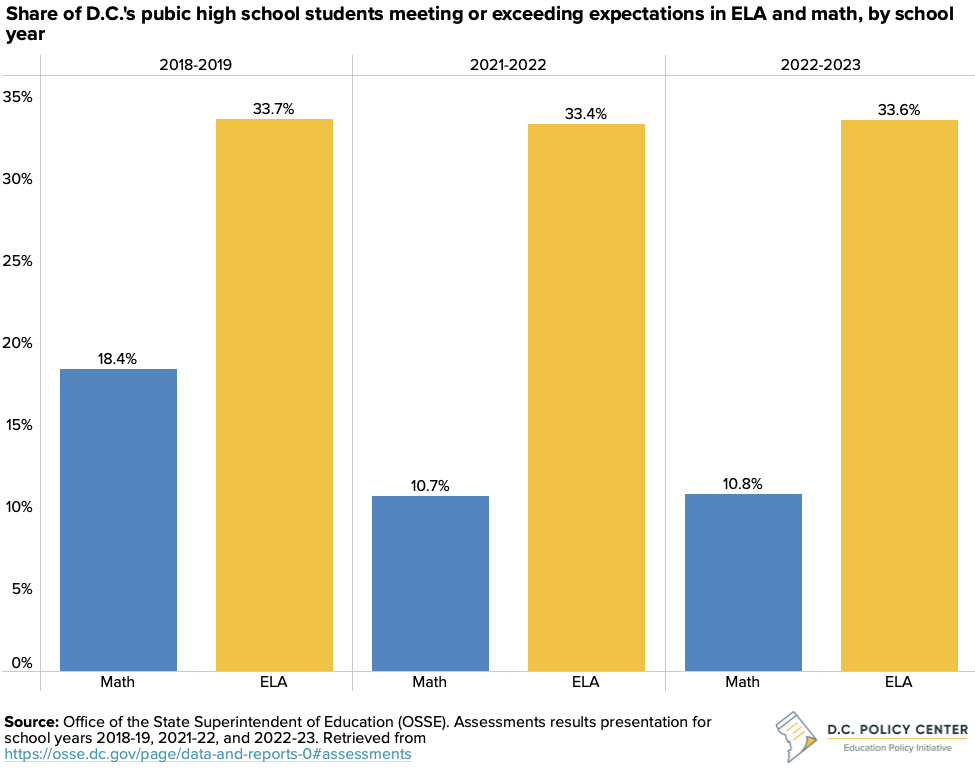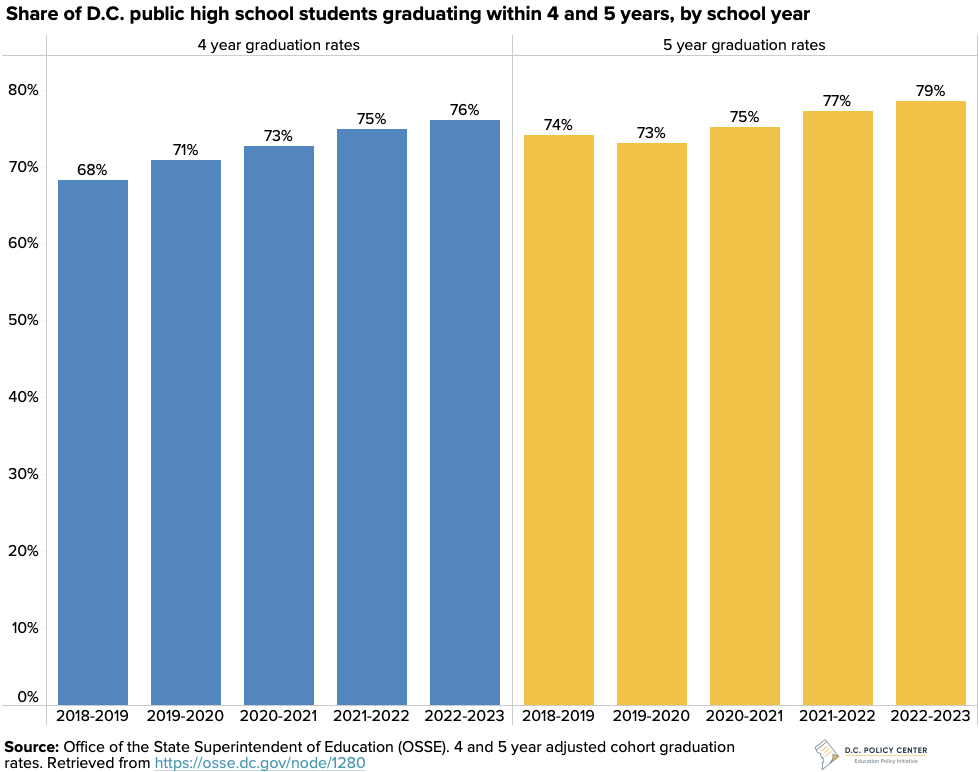High school chronic absenteeism in D.C. increased between pre-pandemic and post-pandemic school years but is on a steady decline according to recent data.1 The Office of the State Superintendent of Education (OSSE) defines chronic absenteeism as missing at least 10 percent of enrolled instructional days (including both excused and unexcused, partial and full-day absences).2 Truancy, on the other hand, is defined as the share of students who have accumulated 10 or more unexcused absences during the school year. In school year 2018-19, 57 percent of high school students were chronically absent.3 This increased by 3.6 percentage points to 60 percent in school year 2022-23.4
As of March 2024, chronic absenteeism for high school students dropped to 51 percent from 54 percent.5 These improvements are widespread across high schools, with 26 out of 35 high schools with data for both years improving chronic absenteeism between years by at least 1 percentage point. This fluctuation underscores the ongoing challenges in maintaining consistent student attendance.
Black and Latino students tend to have higher rates of truancy compared to their white peers. In school year 2018-19, out of all absences, 72.7 percent were unexcused for Black students. For Latino students, out of all absences, 68 percent were unexcused. To put this into perspective, the percentage of unexcused absences for all students during this year was 70 percent.6
In school year 2022-23, Black students were 9.9 times as likely to be chronically truant, but only 3.6 times as likely to be chronically absent compared to white students. Latino students were 5.7 times as likely to be chronically truant, and only 2.6 times as likely to be chronically absent.


In school year 2022-23, 33.6 percent of high school students met or exceeded expectations in English Language Arts (ELA) and 10.8 percent in math on the statewide assessment (PARCC), with no improvement over the previous year.7 Graduation rates, on the other hand, highlight a steady increase reaching 76.1 percent for four-year graduates and 78.5 percent for five-year graduates in the same years.8 More students are graduating, but learning outcomes have not improved.




Addressing chronic absenteeism and truancy requires early intervention, family engagement, and community support which is why consistent attendance is important.9 Students miss school for many reasons, including transportation barriers, negative school experiences, lack of engagement, and attendance misconceptions.10 To gain a more detailed perspective, we asked key stakeholders on their experience with the strengths and challenges of high school attendance for high school students.
Paul Kihn, Deputy Mayor for Education, DME
Students attend school where they find meaning and connection. As a city we must therefore focus effort on making more meaningful and relevant experiences for students—while maintaining high standards—and on building deep, lasting connections.
On meaning, we have elevated our work to reimagine high schools, including through the Advanced Technical Center (ATC), which is led by the Office of the State Superintendent for Education. The ATC has demonstrated that when students see meaning in their classwork, are exposed to cutting-edge technology, and are given access to Career and Technical Education classes regardless of their high school or zip code, they are more engaged. We’re thrilled with evidence that suggests students who attend the ATC are more likely to attend school, and we continue to scale up how many students it serves, including an expansion of the ATC’s footprint east of the Anacostia River.
On connections, we continue to promote strong relationships at school through our mentorship grants and our renewed social-emotional learning efforts that foster community as one core component. Our teachers are highly trained in establishing and maintaining relationships not just with students but also with families.
Of course, other challenges to attendance remain. We must ensure safety, following the playbook recently laid out by the School Safety Enhancement Committee and based in deep community and stakeholder engagement. Safe Passage is evolving to be more flexible; school safety teams are getting access to best practices; safety-related communications into and out of schools grow stronger. We are also focusing energy on consistently absent students, piloting new family supports and Department of Human Services case managers for truant students at five high schools this year.
Attendance is steadily improving, and chronic absenteeism and truancy are steadily dropping. We must stay the course, support our schools, and build more and more meaning and connections for our students.
Raymond Weeden, Executive Director, Thurgood Marshall Academy
Schools play a consistent role in making sure students have access to a high-quality education, and how we go about doing this has shifted since pre-pandemic years. Attendance wasn’t great before the pandemic. While we have achieved 80 to 90 percent of in-seat attendance (ISA), it’s different students every day, and this presents a challenge.
The most persistent barriers impacting attendance are transportation, family scheduling conflicts, and teenage norms, meaning not wanting to wake up or not always having someone there holding them accountable in ensuring they’re getting to school. Solutions to these challenges have included sharing attendance data with parents and students, having a trusted adult students can come to, restructuring student schedules, and hiring tutors and new staff to help checking in on students. There have been shifts in efforts to get to school on time with these solutions which is encouraging given the disappointing attendance numbers in school year 2021-22. Being able to show children you care is important because it makes students want to be in school and be fully engaged.
A more innovative solution to combatting absenteeism is providing a rotating schedule which allows students to attend different classes at different times during the day. This is also helpful to teachers so they can teach students at different times of the day. Combatting absenteeism is going to be done through being aggressive with solutions for students and focusing on chronically late students. Some solutions can be easy or difficult to implement, but this upcoming school year we will be focusing on root causes of absenteeism in order to effectively problem solve.
Chamiya Carnathan, Ward 5 resident, DCPS Student
Attending School Without Walls meant having a huge workload. School Without Walls High School is competitive academically, and there is a lot of work to be done and many assignments to keep up with. This can be particularly stressful. If students were not able to keep up with the amount of work, it is easy to fall behind. This contributes to students having multiple absences from school. When students are chronically absent, they will have to make up their missed work. In some cases, this isn’t manageable because of the heavy workload. Students typically stay home because they are concerned about their work. They try to manage and catch up on late assignments that haven’t been turned in. Skipping school to complete work may seem counterintuitive, but the role of school has been changed to getting good grades in the first place.
Another reason students miss a lot of school is due to medical reasons. Recovery from medical reasons can take an extensive period of time which can lead students to fall behind in school. If students don’t feel that the make-up work is sufficient, then it may lead them to skip. Students may have days where they may not have the strength to go to school and end up missing useful information. Also, if students feel that the days can be repetitive, it is very possible that it may lead them to skip school and study independently. During social hours, students of color were very unlikely to participate in activities that catered towards predominantly white students. It led them to skipping activities during school hours, feeling excluded and not represented.
There are other reasons that drive students to go to school such as socializing, amplifying passions, and obtaining good grades. The school environment enables time for friends, teams, and social clubs such as Mikva Challenge. This non-profit organization works with high school students to push advocacy efforts on numerous issues inside of D.C. schools. Mikva Challenge has enabled the youth to be more active in their community. Earning good grades also pushes students to attend school because ultimately, they want to graduate.
Kisha Clark, Ward 6 PLE Board Member, Parents Amplifying Voices in Education
As a mother of two girls both graduating from DCPS, witnessing chronic absenteeism through personal experience and through other students’ experiences became a norm. Different barriers that have led to students not attending school consistently are bullying, harassment, and disengagement.
Students are very conscious of how bullying impacts their day-to-day experience in school. It’s easier to stay home when mental health issues stemming from bullying and other issues that are not being addressed are exacerbated. If schools lack enough support when students arrive at school, it follows that they will be less engaged and less likely to attend altogether.
Disengagement and school being less interesting is also a huge challenge for students attending school consistently. From personal experience, as a junior in high school, when student materials focus on predominately white events, it’s difficult to find relatability and the ability to connect.
However, with a change of curriculum after switching schools, this student found deeper reliability when reading Afro-Centric literature such as “A Raisin in the Sun.” This led to a change in behavior, higher engagement in school which in turn increased attendance throughout the year. When students have materials they can resonate with it, it inspires them to keep learning and wanting more.
Increasing attendance rates can also happen by having a community-based organization that focuses on attendance and skipping classes when students are already in the building. Working with school counselors and providing resources that allow students a break from class, more mental health supports, and more support around student safety when commuting to school, positive results in attendance will happen.
Endnotes
- Office of the State Superintendent of Education. 2024. 2023-24 Mid-Year Attendance Brief. Retrieved from https://osse.dc.gov/sites/default/files/dc/sites/osse/page_content/attachments/Mid_Year_Attendance_1Pager%206_14_2024.pdf
- Office of the State Superintendent of Education (OSSE). 2023. District of Columbia Attendance Report: 2022-23 school year. Retrieved from https://osse.dc.gov/sites/default/files/dc/sites/osse/publication/attachments/2022-23%20Attendance%20Report_FINAL_0.pdf
- Office of the State Superintendent of Education (OSSE). DC School Report Card – Student Attendance. Retrieved from https://schoolreportcard.dc.gov/state/report/explore/102
- Office of the State Superintendent of Education (OSSE). 2023. District of Columbia Attendance Report – 2022-23 School Year. Retrieved from https://osse.dc.gov/sites/default/files/dc/sites/osse/publication/attachments/2022-23%20Attendance%20Report_FINAL_0.pdf
- Office of the State Superintendent of Education. 2024. 2023-24 Mid-Year Attendance Brief. Retrieved from https://osse.dc.gov/sites/default/files/dc/sites/osse/page_content/attachments/Mid_Year_Attendance_1Pager%206_14_2024.pdf
- Office of the State Superintendent of Education. (OSSE). District of Columbia Attendance Report for school year 2018-19. Retrieved from https://osse.dc.gov/sites/default/files/dc/sites/osse/publication/attachments/2018-19%20School%20Year%20Attendance%20Report.pdf
- Office of the State Superintendent of Education (OSSE). 2023. DC School Report Card. Retrieved from https://schoolreportcard.dc.gov/state/report/explore/100
- Office of the State Superintendent of Education (OSSE). 2023. Graduation Rates. Retrieved from https://osse.dc.gov/page/data-and-reports-0
- Attendance Works. Addressing Chronic Absence. Retrieved from https://www.attendanceworks.org/chronic-absence/addressing-chronic-absence/
- Attendance Works. Why are so many students missing school? Retrieved from https://www.attendanceworks.org/resources/toolkits/teaching-attendance-2-0/use-data-for-intervention-and-support/strategy-2-consider-needed-supports/why-are-so-many-students-missing-so-much-school/
